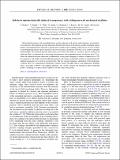| dc.contributor.author | Bodiya, T | |
| dc.contributor.author | Sudhir, V | |
| dc.contributor.author | Wipf, C | |
| dc.contributor.author | Smith, N | |
| dc.contributor.author | Buikema, A | |
| dc.contributor.author | Kontos, A | |
| dc.contributor.author | Yu, H | |
| dc.contributor.author | Mavalvala, N | |
| dc.date.accessioned | 2021-10-27T20:11:01Z | |
| dc.date.available | 2021-10-27T20:11:01Z | |
| dc.date.issued | 2019 | |
| dc.identifier.uri | https://hdl.handle.net/1721.1/135160 | |
| dc.description.abstract | © 2019 American Physical Society. Optical interferometers with suspended mirrors are the archetype of all current audio-frequency gravitational-wave detectors. The radiation pressure interaction between the motion of the mirrors and the circulating optical field in such interferometers represents a pristine form of light-matter coupling, largely due to 30 years of effort in developing high-quality optical materials with low mechanical dissipation. However, in all current suspended interferometers, the radiation pressure interaction is too weak to be useful as a resource, and too strong to be neglected. Here, we demonstrate a meter-long interferometer with suspended mirrors, of effective mass 125g, where the radiation pressure interaction is enhanced by strong optical pumping to realize a cooperativity of 50. In conjunction with modest resolved-sideband operation, this regime is efficiently probed via optomechanically induced transparency of a weak on-resonant probe. The low resonant frequency and high-Q of the mechanical oscillator allows us to demonstrate transparency windows barely 100 mHz wide at room temperature. Together with a near-unity (≈99.9%) out-coupling efficiency, our system saturates the theoretical delay-bandwidth product, rendering it an optical buffer capable of seconds-long storage times. | |
| dc.language.iso | en | |
| dc.publisher | American Physical Society (APS) | |
| dc.relation.isversionof | 10.1103/PHYSREVA.100.013853 | |
| dc.rights | Article is made available in accordance with the publisher's policy and may be subject to US copyright law. Please refer to the publisher's site for terms of use. | |
| dc.source | APS | |
| dc.title | Sub-hertz optomechanically induced transparency with a kilogram-scale mechanical oscillator | |
| dc.type | Article | |
| dc.contributor.department | Lincoln Laboratory | |
| dc.contributor.department | LIGO (Observatory : Massachusetts Institute of Technology) | |
| dc.relation.journal | Physical Review A | |
| dc.eprint.version | Final published version | |
| dc.type.uri | http://purl.org/eprint/type/JournalArticle | |
| eprint.status | http://purl.org/eprint/status/PeerReviewed | |
| dc.date.updated | 2021-07-06T15:30:11Z | |
| dspace.orderedauthors | Bodiya, T; Sudhir, V; Wipf, C; Smith, N; Buikema, A; Kontos, A; Yu, H; Mavalvala, N | |
| dspace.date.submission | 2021-07-06T15:30:13Z | |
| mit.journal.volume | 100 | |
| mit.journal.issue | 1 | |
| mit.license | PUBLISHER_POLICY | |
| mit.metadata.status | Authority Work and Publication Information Needed | |
